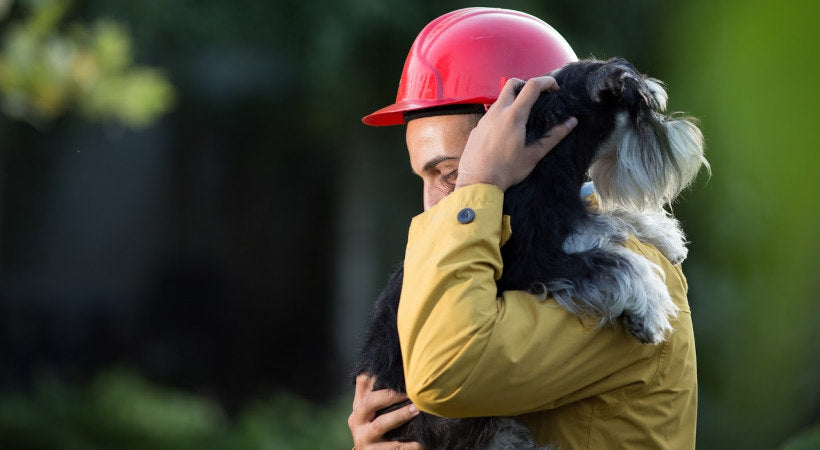Sit Down Dog Wheelchairs

Creating a Natural Disaster Readiness Kit for Your Pet
The recent fires along the west coast of the United States and hurricanes slamming the Gulf of Mexico remind us how rapidly natural disasters can hit and the devastating toll they can have. While footage of charred forests or wave-battered beaches may have caused you to consider what you might do to protect you and your family in a similar situation, one thing you might have overlooked is a plan for protecting your precious pets.
Take the case of Judy Pugh. Judy was in her home in Tuscaloosa, Alabama when a tornado struck. Before she could escape, much of her home was lifted into the air around her and she was left pinned under a fallen wall. Almost immediately after being rescued, Judy began searching for her three cats. Two were found quickly, but the oldest, Cadie, was gone and feared to have been taken by the storm.
However, in what seemed a made-for-TV moment, a local station who saw Pugh searching for her beloved cat stopped to interview her. Halfway into the taping, Cadie crept from what remained of Pugh’s home. The crying owner was heard to exclaim, “I have everything in the world now.”
Judy was lucky, and she voices the way we often feel about the animals that are our everyday companions. But in the face of an impending disaster, we don’t want to be a Judy. In other words, we don’t want to rely on luck to keep our pets safe.
What we want instead is to know the best ways to be prepared, not only to protect ourselves but also to protect our animals.
Starter Checklist:

- Two weeks’ worth of non-perishable pet food
- Dog water bottles & collapsible bowls
- Lightweight dog harness
- Dog backpack carrier
- Pop-up dog kennel
- Reflective pet life jacket
- Paw protectors -- especially in hot conditions, such as wildfire-impacted areas
- Foldable pet stretcher
- Vet’s contact info & pet’s medical history record
- Backup medications
- First aid kit (cotton bandage rolls, bandage tape and scissors, antibiotic ointment, flea and tick prevention, latex gloves, isopropyl alcohol, saline solution and a pet first aid book)
- Sanitation needs (litter box and kitty litter, newspapers, paper towels, doggie bags, and household chlorine bleach)
Tip: For pets with mobility issues use a pet stretcher to safely move your pet in an emergency situation.
Have a Plan in Place
Just as you would for yourself or your family, one of the most important steps is to have a plan in place for how to deal with your animals if disaster strikes. One of the first things to consider is the type of disasters that are likely to strike in your area. This may dictate some of the things you’ll need to have on hand.
In flood areas for example, you will want to have some sort of flotation device for your pet, while in fire prone areas, you may need to have boots to protect against heat or a carrier to keep the animal off the ground.
In a disaster, you’ll want to know where to go with your pet. Not all shelter facilities except animals, so it’s a good idea to investigate in advance which ones do or to have plans for relocating your pet to an animal shelter or boarding facility. Having a list of options with addresses and phone numbers as part of your readiness kit will save you valuable time and prevent being stuck with no place to go.
Make Your Pet Identifiable
Experts also recommend having a buddy who knows this information so that if you aren’t at home, they can take care of your pet (and you can do the same for them). In the unfortunate case that you cannot escape with your animal, there are waterproof stickers you can purchase and place on your home that say, “Pets inside.”
Other important steps are to be sure your pet has a permanent collar with address and contact info attached. Or better yet, have your animal microchipped so that they can be easily identified if found. Have a list of vets you trust and their contact information in your readiness kit as well. And remember that some shelters won’t allow animals without a record of vaccinations, so include these, too.
Putting the Kit Together
Finally, you should have a pet readiness kit prepared containing the items in the checklist with the essentials to care for your four-legged friend while you shelter. One of the most important items is a foldable, pop-up dog kennel. Not only for transporting the animal if you have to evacuate quickly, but also as a means of containing them should you end up in a shelter.
A compact dog backpack carrier can also fit easily in your emergency kit and will allow you to quickly transport your pet out of a dangerous situation while carrying them on your back. Remember, that animals can behave unpredictably in times of stress. So being able to contain them around others is important to keeping both your animal and those around you safe.
In terms of having non-perishable pet food available to your pet, you may opt for some freeze-dried products. Many brands, such as Stella & Chewy’s and Primal, create long-lasting and highly-reviewed dehydrated products.
A prepared owner is a prepared pet. And with this little bit of forethought, you are less likely to be caught without the necessities to keep your animal healthy and safe. If you’re lucky, you’ll never have to face a natural disaster. But if you ever do, don’t be a Judy. Don’t count on luck. Have your plan well thought out and your kit ready to go.








